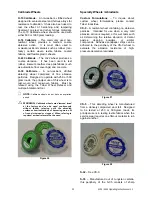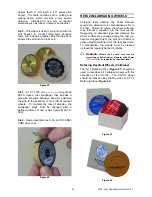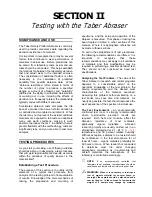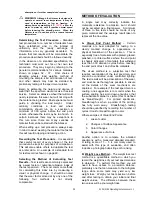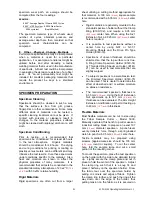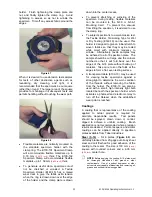
with 250 or 500 gram load.
Evaluation: Visual change in gloss.
Paper and Cardboard – Abrasion
Resistance
Specimen: 100 mm
(4 inch)
diameter or square
with 6.35 mm
(0.25 inch)
center hole for
sufficiently rigid materials; for flexible materials,
108 mm
(4.25 inch)
diameter or square with 6.35
mm
(0.25 inch)
center hole center hole mounted
on S-36 or S-36-1 Mounting Card.
Wheels and Load: CS-10 Calibrase with 250
gram or 500 gram load.
Evaluation: Visual changes (i.e. loss of luster;
changes of surface; etc.); weight loss method.
Remark: Duration of the test is a predetermined number of
cycles (i.e. 100, 300, 500 or whatever number is needed to
reach the degree of wear to be regarded as the end point of
the test). The loss in milligrams is calculated on a 1000 cycle
basis which gives a Taber numerical wear index directly
comparable with that of similar materials tested under the
same conditions.
Paste (Powder)
Specimen: Paste (i.e. toothpaste) or a paste
made of powder and water, applied as a thin
layer to acetate indicator plates.
Wheels and Load: CS-0 or S-32 Calibrase with
250 or 500 gram load.
Evaluation: Visual method, by comparison of the
number of wear cycles necessary to produce an
equal degree of haze or scratching with that of a
standard of identical material tested under
identical conditions.
Porcelain Enamel
Specimen: Prepared on S-16 or similar plate
[100 mm
(4 inch)
square with 6.35 mm
(0.25 inch)
center hole].
Wheels and Load: CS-17 with 1000 gram load.
Evaluation: Visual method, based on number of
cycles to the first sizeable scratch as the wheels
begin to penetrate the surface glaze. Also by
comparison with a standard of the same material
tested under identical conditions. If desired, the
test may be continued to a more advanced end
point than the first sizeable scratch.
Remark 1: The hardness and density of porcelain enamel
makes them highly resistant to abrasion and scratching.
Because of the similarity of porcelain glaze with glass, the
abrading action of the Calibrase wheels is barely noticeable
in the early stages of the test although material is being
slowly removed. After a time, however, the wheels begin to
abrade through the surface glaze and penetrate the coarse
substrate.
Remark 2: Porcelain enamel frit may be sprayed on S-16
plates for testing or specimens may be cut either before or
after firing from multiple sheets. Shearing and punching of
the plates is likely to cause some shattering of the enamel,
this is permissible if it does not extend into the path of the
wheels.
Remark 3: Special care must be taken to avoid warping the
plates in firing, since flatness of the specimen is essential to
accurate test results. Should the 20 gage S-16 specimen
plate prove too thin to withstand the heat without warping,
use heavier metal for plates.
Plastics – Transparent (Figure 77)
Specimen: 100 mm
(4 inch)
diameter or square
with 6.35 mm
(0.25 inch)
center hole.
Wheels and Load: CS-10F with 500 gram load.
Evaluation: Change in the percentage of
transmitted light and percent haze, before and
after exposure to abrasion as measured by a
hazemeter.
Remark 1: Reface wheels with fine side of ST-11 refacing
stone.
Remark 2: For transparent specimens, care must be taken to
mount the test specimen such that the bottom surface is not
scratched nor subjected to abrasion.
Remark 3: The use of an oversized nozzle is recommended
[11mm
(0.4375 inch)
opening vs. the nominal 8mm
(0.3125
inch)
].
Figure 77
Plastics – Opaque
Specimen: 100 mm
(4 inch)
diameter or square
(molded, sheared, or sawed) with 6.35 mm
(0.25
inch)
center hole for material to 6.35 mm
(0.25 inch)
thick; 9.525 mm
(0.375 inch)
hole for S-21
extension nut for material 6.35 mm
(0.25 inch)
to
12.7 mm
(0.5 inch)
thick..
Wheels and Load: CS-17 or CS-10 Calibrase
with 1000 gram load.
Evaluation: Weight loss method.
Remark: The CS-17 Calibrase wheel under 1000 grams
37
5135 / 5155 Operating Instructions ver 1.1

